NASA: SpaceCast Weekly, A New Source of Power for the Space Station, NASA ARSET, Expedition 64 In-Flight with MSNBC, Spacewalk, SpaceX: Starlink Mission, Starship | SN9 | High-Altitude Flight Test, and NASA – Image of the Day, Solar System and More
NASA: SpaceCast Weekly – February 5, 2021, Feb 5, 2021 NASA Video
NASA: A New Source of Power for the Space Station on This Week @NASA – February 5, 2021
NASA ARSET: Hyperspectral Data for Coastal and Ocean Systems, Part 3/3, Feb 3, 2021 NASA Video
NASA: Expedition 64 In-Flight with MSNBC – February 4, 2021, NASA Video
NASA: Spacewalk to Finish Battery Upgrades & Install Cameras on
The International Space Station, Streamed live on Feb 1, 2021
SpaceX: Starlink Mission, Streamed live on Feb 4, 2021 (1:20:58)
SpaceX: Starship | SN9 | High-Altitude Flight Test, Streamed live on Feb 2, 2021
NASA: LATEST IMAGES – Image of the Day, Solar System and More
SpaceCast Weekly – February 5, 2021
Feb 5, 2021 NASA Video
SpaceCast Weekly is a NASA Television broadcast from the Johnson Space Center in Houston featuring stories about NASA’s work in human spaceflight, including the International Space Station and its crews and scientific research activities, and the development of Orion and the Space Launch System, the next generation American spacecraft being built to take humans farther into space than they’ve ever gone before.
A New Source of Power for the Space Station on This Week @NASA – February 5, 2021
Feb 5, 2021 NASA
A new source of power for the space station, targeting a second Green Run hot fire test, and another major boost for our Space Launch System rocket … a few of the stories to tell you about – This Week at NASA! Download Link: https://images.nasa.gov/details-A%20N…
Expedition 64 Astronauts Speak with National Science Foundation – February 3, 2021
Feb 3, 2021 NASA Video
SPACE STATION CREW DISCUSSES LIFE IN SPACE WITH NATIONAL SCIENCE FOUNDATION Aboard the International Space Station, Expedition 64 Flight Engineers Kate Rubins and Victor Glover of NASA discussed research and other aspects of life in space during an in-flight conversation Feb. 3 with members of the National Science Foundation. Rubins, who is an epidemiologist, arrived on the station last October aboard a Russian Soyuz spacecraft, while Glover flew to the station last November aboard the SpaceX Crew Dragon “Resilience” vehicle.
NASA ARSET: Hyperspectral Data for Coastal and Ocean Systems, Part 3/3
Feb 3, 2021 NASA Video
Hyperspectral Data for Land and Coastal Systems Part 3: Hyperspectral Data for Coastal and Ocean Systems – Use of hyperspectral imaging for wetland vegetation communities – Use of hyperspectral for coastal shallow-water ecosystems – Use of hyperspectral for marine debris – Case study examples – Q&A You can access all training materials from this webinar series on the training webpage: https://appliedsciences.nasa.gov/join…? This training was created by NASA’s Applied Remote Sensing Training Program (ARSET). ARSET is a part of NASA’s Applied Science’s Capacity Building Program. Learn more about ARSET: appliedsciences.nasa.gov/arset
Expedition 64 In-Flight with MSNBC – February 4, 2021
Feb 4, 2021 NASA Video
SPACE STATION CREW MEMBER DISCUSSES LIFE IN SPACE WITH MSNBC Aboard the International Space Station, Expedition 64 Flight Engineer Victor Glover of NASA discussed life and work on the outpost and his view of astronauts serving as role models during an in-flight interview Feb. 4 with MSNBC anchor Kendis Gibson. Glover, who is involved in a series of spacewalks outside the complex, arrived on the station last November aboard the SpaceX Crew Dragon “Resilience” vehicle.
Spacewalk to Finish Battery Upgrades & Install Cameras on the International Space Station
Streamed live on Feb 1, 2021 NASA
Watch two spacewalkers at work outside the International Space Station! NASA astronauts Victor Glover and Michael Hopkins will exit the orbiting lab’s Quest airlock at about 7 a.m. EST, to complete tasks including battery maintenance and installing high definition cameras. Live coverage on NASA Television begins at 5:30? a.m.. The spacewalk will officially begin once the duo set their spacesuits to battery power, and is scheduled to last approximately six-and-a-half hours.
License
Creative Commons Attribution license (reuse allowed)
Starlink Mission
Streamed live on Feb 4, 2021 (1:20:58) SpaceX
SpaceX is targeting Thursday, February 4 for launch of 60 Starlink satellites from Space Launch Complex 40 (SLC-40) at Cape Canaveral Space Force Station in Florida. The instantaneous window is at 1:19 a.m. EST, or 6:19? UTC. The Falcon 9 first stage rocket booster supporting this mission previously flew on four missions: the launches of GPS III Space Vehicle 03 and Turksat 5A and two Starlink missions. Following stage separation, SpaceX will land Falcon 9’s first stage on the “Of Course I Still Love You” droneship, which will be located in the Atlantic Ocean. One half of Falcon 9’s fairing previously flew on the SAOCOM-1B mission, and the other previously flew in support of the GPS III Space Vehicle 03 mission.
Starship | SN9 | High-Altitude Flight Test
Streamed live on Feb 2, 2021 SpaceX
On Tuesday, February 2, Starship serial number 9 (SN9) completed SpaceX’s second high-altitude flight test of a Starship prototype from our site in Cameron County, Texas. Similar to the high-altitude flight test of Starship serial number 8 (SN8), SN9 was powered through ascent by three Raptor engines, each shutting down in sequence prior to the vehicle reaching apogee – approximately 10 kilometers in altitude. SN9 successfully performed a propellant transition to the internal header tanks, which hold landing propellant, before reorienting itself for reentry and a controlled aerodynamic descent. The Starship prototype descended under active aerodynamic control, accomplished by independent movement of two forward and two aft flaps on the vehicle. All four flaps are actuated by an onboard flight computer to control Starship’s attitude during flight and enable precise landing at the intended location. During the landing flip maneuver, one of the Raptor engines did not relight and caused SN9 to land at high speed and experience a RUD. These test flights are all about improving our understanding and development of a fully reusable transportation system designed to carry both crew and cargo on long-duration, interplanetary flights and help humanity return to the Moon, and travel to Mars and beyond.
NASA: LATEST IMAGES – Image of the Day, Solar System
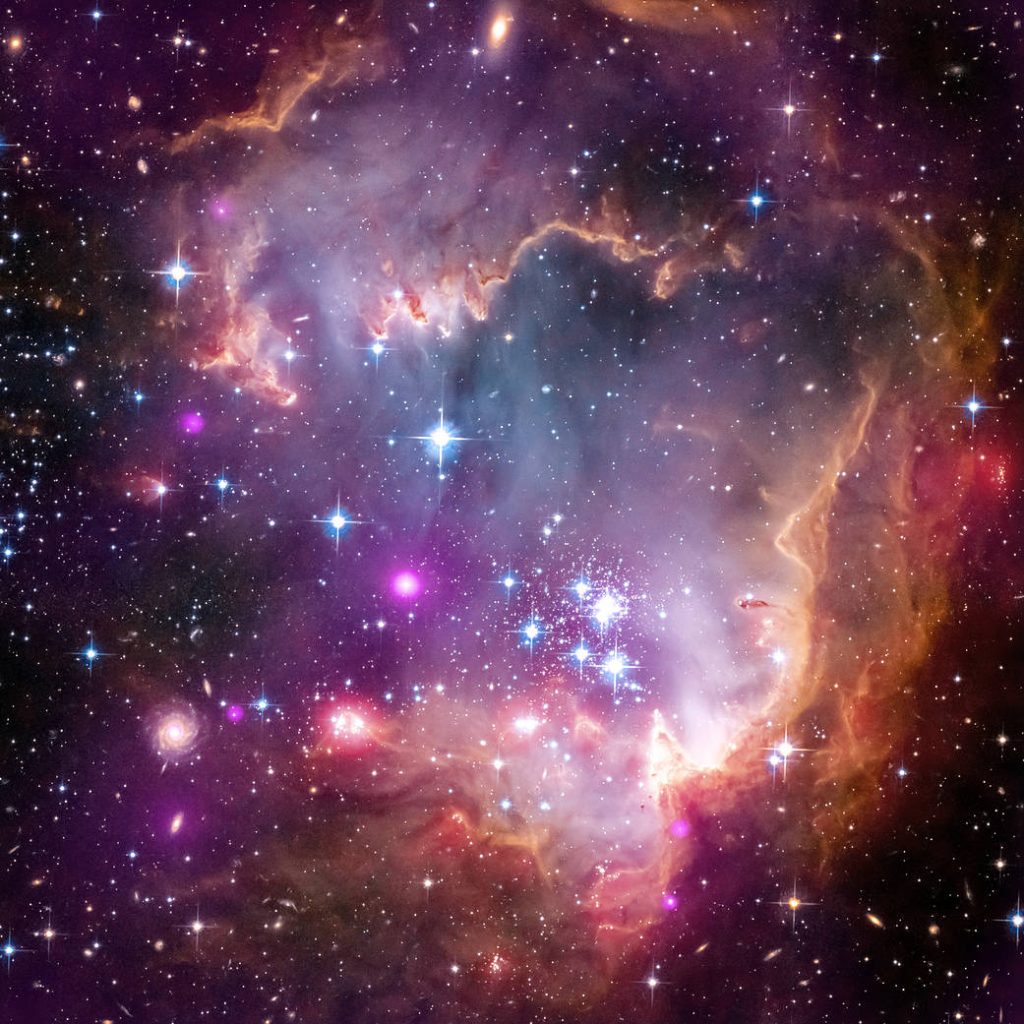
The tip of the “wing” of the Small Magellanic Cloud galaxy is dazzling in this 2013 view from NASA’s Great Observatories. The Small Magellanic Cloud, or SMC, is a small galaxy about 200,000 light-years way that orbits our own Milky Way spiral galaxy.
The colors represent wavelengths of light across a broad spectrum. X-rays from NASA’s Chandra X-ray Observatory are shown in purple; visible-light from NASA’s Hubble Space Telescope is colored red, green and blue; and infrared observations from NASA’s Spitzer Space Telescope are also represented in red.
The spiral galaxy seen in the lower corner is actually behind this nebula. Other distant galaxies located hundreds of millions of light-years or more away can be seen sprinkled around the edge of the image.
The SMC is one of the Milky Way’s closest galactic neighbors. Even though it is a small, or so-called dwarf galaxy, the SMC is so bright that it is visible to the unaided eye from the Southern Hemisphere and near the equator. Many navigators, including Ferdinand Magellan who lends his name to the SMC, used it to help find their way across the oceans.
Modern astronomers are also interested in studying the SMC (and its cousin, the Large Magellanic Cloud), but for very different reasons. Because the SMC is so close and bright, it offers an opportunity to study phenomena that are difficult to examine in more distant galaxies. New Chandra data of the SMC have provided one such discovery: the first detection of X-ray emission from young stars, with masses similar to our sun, outside our Milky Way galaxy.
Image Credit: NASA/CXC/JPL-Caltech/STScI
Last Updated: Feb 5, 2021
Editor: Yvette Smith
Tags: Image of the Day, Solar System
Feb 5, 2021
Hubble Sees a Stellar Furnace
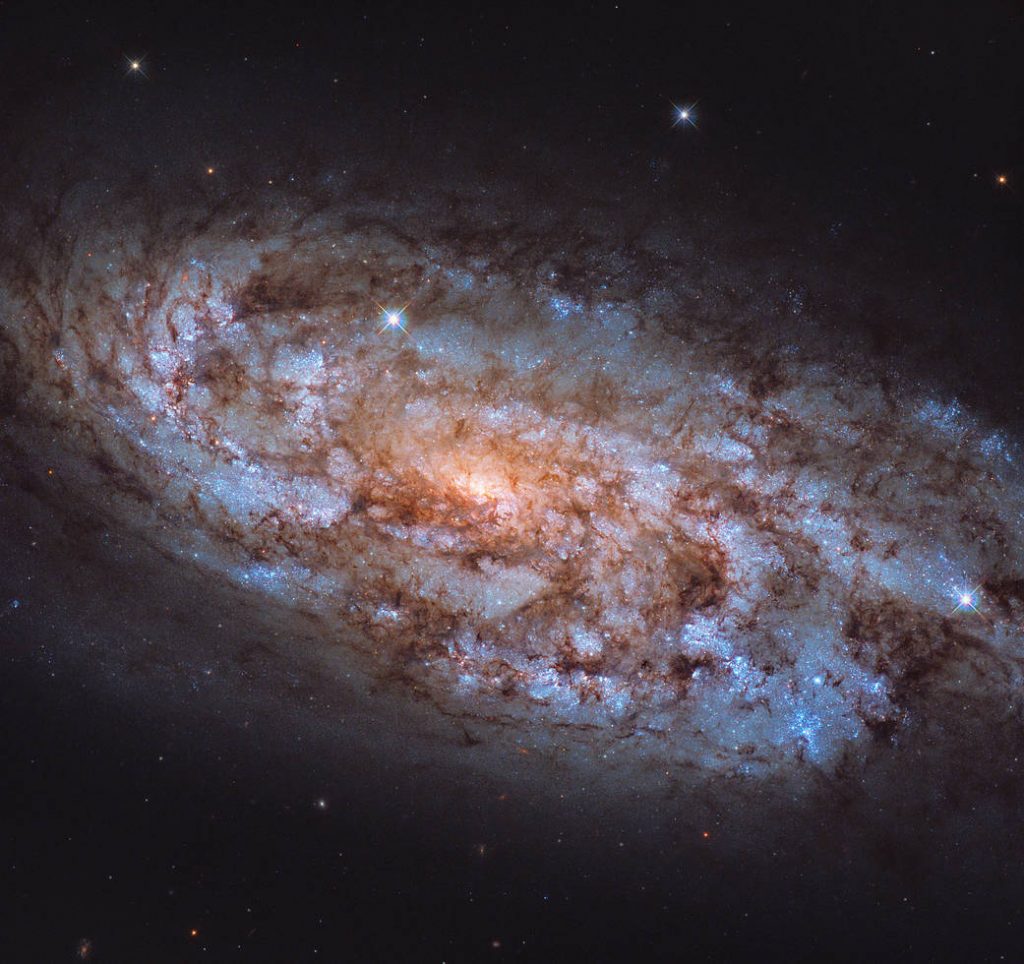
Text credit: European Space Agency (ESA)
Image credit: ESA/Hubble & NASA, J. Lee; Acknowledgement: Leo Shatz
Last Updated: Feb 5, 2021
Editor: Lynn Jenner
Tags: Galaxies, Goddard Space Flight Center, Hubble Space Telescope, Universe

Feb 4, 2021
SOFIA Begins First Series of Science Flights From Germany
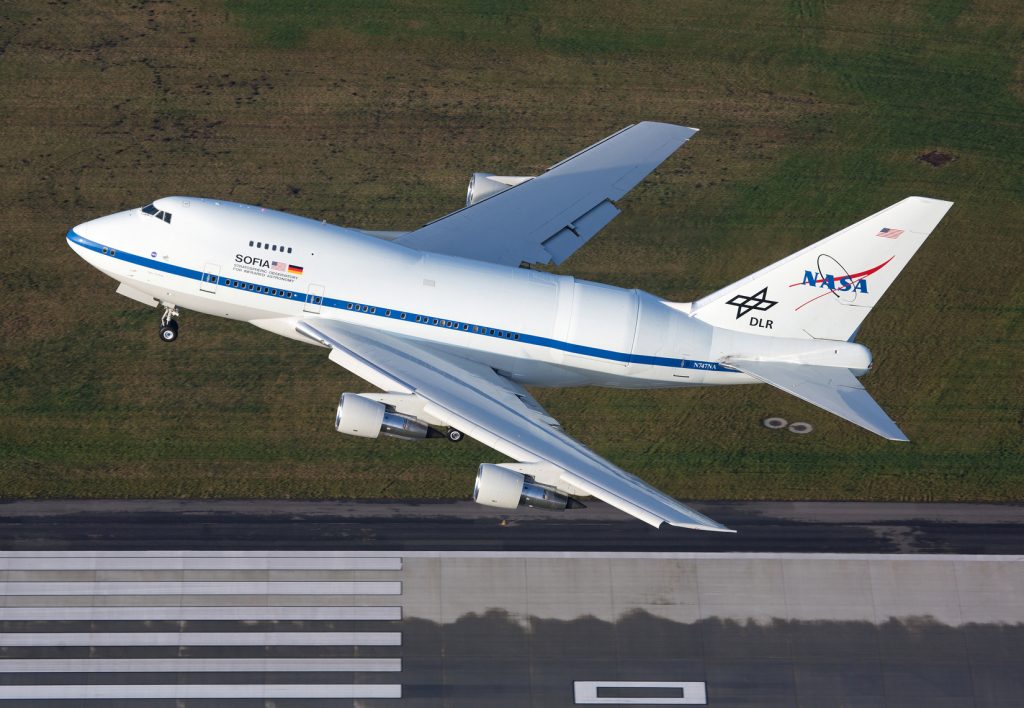
SOFIA taking off from Hamburg, Germany, after finishing heavy maintenance at Lufthansa Technik.
Credits: Alexander Golz
NASA’s Stratospheric Observatory for Infrared Astronomy, SOFIA, will conduct its first ever series of science observations from Germany in February and March, 2021. Many of the observations seek to answer fundamental questions in astronomy, including how stars can transform galaxies and what is the origin of cosmic rays in the Milky Way galaxy.
SOFIA, a joint project of NASA and the German Aerospace Center, DLR, recently completed scheduled maintenance and telescope upgrades at Lufthansa Technik’s facility in Hamburg, Germany. Now, the observatory will take advantage of its proximity to science teams at the Max Planck Institute of Radio Astronomy in Bonn and the University of Cologne, which operate the instrument called German Receiver at Terahertz Frequencies, or GREAT, to conduct research flights from the Cologne Bonn Airport.
“We’re taking advantage of SOFIA’s ability to observe from almost anywhere in the world to conduct compelling astronomical investigations,” said Paul Hertz, director of astrophysics at NASA Headquarters in Washington. “This observing campaign from Germany is an excellent example of the cooperation between NASA and DLR that has been the strength of the SOFIA program for over 25 years.”
SOFIA regularly flies to Christchurch, New Zealand, to study objects only visible in the skies over the Southern Hemisphere, and completed one science flight from Germany in 2019. But this is the first time a multi-flight observing campaign will be conducted over European soil. Over the course of six weeks, SOFIA will conduct about 20 overnight research flights that will focus on high-priority observations, including several large programs that were rescheduled from spring 2020 due to the COVID-19 pandemic.
With new COVID-19 safety procedures in place, SOFIA will use its GREAT instrument to search for signatures of celestial molecules, ions, and atoms that are key to unlocking some of the secrets of the universe.
The observations include:
How Stars Affect Their Surroundings
In stellar nurseries like Cygnus X, newborn stars can destroy the clouds in which they’re born. Researchers will use SOFIA to create a map of ionized carbon, a gas the young stars are heating, to better understand this process. Ionized carbon’s chemical fingerprint can determine the speed of the gas at all positions across the celestial clouds. The signal is so strong that it reveals critical details that are otherwise hidden from view deep inside natal clouds. The data may also help explain the source of the mysterious bubble-like structures that were detected by the Herschel Space Observatory and Spitzer Space Telescope but have yet to be fully understood.
Searching for Clues About Cosmic Rays
The team will search for gases that can reveal the presence of cosmic rays, highly energetic charged particles that stream through our Milky Way galaxy. When a hydrogen atom combines with another element, such as argon or oxygen, simple molecules called hydrides are formed, some of which can be used to find cosmic rays. While cosmic rays can be detected directly within our solar system, astronomers know much less about their presence elsewhere in space. By measuring the concentration of hydride molecules, SOFIA’s observations will help researchers understand how common cosmic rays are in different parts of our galaxy, providing clues about the origin of these mysterious particles.
Understanding the Evolution of The Cigar Galaxy, or M82
SOFIA previously found that the Cigar galaxy’s powerful wind, driven by the galaxy’s high rate of star birth, is aligned along the magnetic field lines and transports a huge amount of material out of the galaxy. Now, researchers will study ionized carbon gas, which traces star formation, to learn how this intense star birth and wind are affecting the evolution of the galaxy.
About GREAT
SOFIA’s GREAT instrument works like a radio receiver. Scientists tune to the frequency of the molecule they’re searching for, like tuning an FM radio to the right station. The instrument can also look for changes in signals that provide insights into how stars affect their surroundings, similar to how a radar gun bounces a signal off a moving car to determine its speed.
About SOFIA
SOFIA is a joint project of NASA and the German Aerospace Center. NASA’s Ames Research Center in California’s Silicon Valley manages the SOFIA program, science, and mission operations in cooperation with the Universities Space Research Association, headquartered in Columbia, Maryland, and the German SOFIA Institute at the University of Stuttgart. The aircraft is maintained and operated by NASA’s Armstrong Flight Research Center Building 703, in Palmdale, California.
Media Contact:
Elizabeth Landau
NASA Headquarters, Washington
202-358-0845
elizabeth.r.landau@nasa.gov
Alison Hawkes
NASA Ames Research Center, Silicon Valley, Calif.
650-604-4789
alison.hawkes@nasa.gov
Last Updated: Feb 4, 2021
Editor: Kassandra Bell
Tags: Ames Research Center, SOFIA, Universe
Feb 4, 2021
RELEASE 21-013
NASA Awards Launch Services Contract for SPHEREx Astrophysics Mission
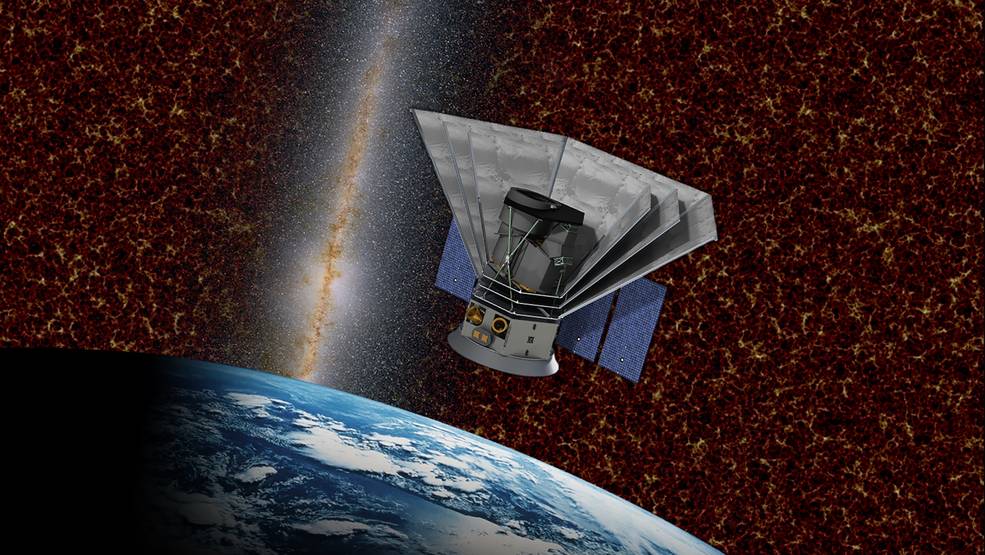 NASA’s Spectro-Photometer for the History of the Universe, Epoch of Reionization and Ices Explorer (SPHEREx) mission is targeted to launch in 2024. SPHEREx will help astronomers understand both how our universe evolved and how common are the ingredients for life in our galaxy’s planetary systems.
NASA’s Spectro-Photometer for the History of the Universe, Epoch of Reionization and Ices Explorer (SPHEREx) mission is targeted to launch in 2024. SPHEREx will help astronomers understand both how our universe evolved and how common are the ingredients for life in our galaxy’s planetary systems.
Credits: Caltech
NASA has selected Space Exploration Technologies (SpaceX) of Hawthorne, California, to provide launch services for the Spectro-Photometer for the History of the Universe, Epoch of Reionization, and Ices Explorer (SPHEREx) mission. SPHEREx is a planned two-year astrophysics mission to survey the sky in the near-infrared light, which, though not visible to the human eye, serves as a powerful tool for answering cosmic questions involving the birth of the universe, and the subsequent development of galaxies.
It also will search for water and organic molecules – essentials for life as we know it – in regions where stars are born from gas and dust, known as stellar nurseries, as well as disks around stars where new planets could be forming. Astronomers will use the mission to gather data on more than 300 million galaxies, as well as more than 100 million stars in our own Milky Way galaxy.
The total cost for NASA to launch SPHEREx is approximately $98.8 million, which includes the launch service and other mission related costs.
The SPHEREx mission currently is targeted to launch as early as June 2024 on a Falcon 9 rocket from Space Launch Complex-4E at Vandenberg Air Force Base in California.
NASA’s Launch Services Program at the agency’s Kennedy Space Center in Florida will manage the SpaceX launch service. The mission, which is funded by the Astrophysics Division of NASA’s Science Mission Directorate at the agency’s headquarters in Washington, is led by the Explorer’s Program at NASA’s Goddard Space Flight Center in Greenbelt, Maryland. NASA’s Jet Propulsion Laboratory in Southern California is responsible for the mission’s overall project management, systems engineering, integration, and testing and mission operations.
For more information about NASA programs and missions, visit: http://www.nasa.gov
Joshua Finch
Headquarters, Washington
202-358-1100
joshua.a.finch@nasa.gov
Patti Bielling
Kennedy Space Center, Fla.
321-867-9284
patricia.a.bielling@nasa.gov
Last Updated: Feb 4, 2021
Editor: Sean Potter
Tags: Galaxies, Kennedy Space Center, Universe
Feb 3, 2021
NASA, International Partners Assess Mission to Map Ice on Mars, Guide Science Priorities
NASA and three international partners have signed a statement of intent to advance a possible robotic Mars ice mapping mission, which could help identify abundant, accessible ice for future candidate landing sites on the Red Planet. The agencies have agreed to establish a joint concept team to assess mission potential, as well as partnership opportunities.
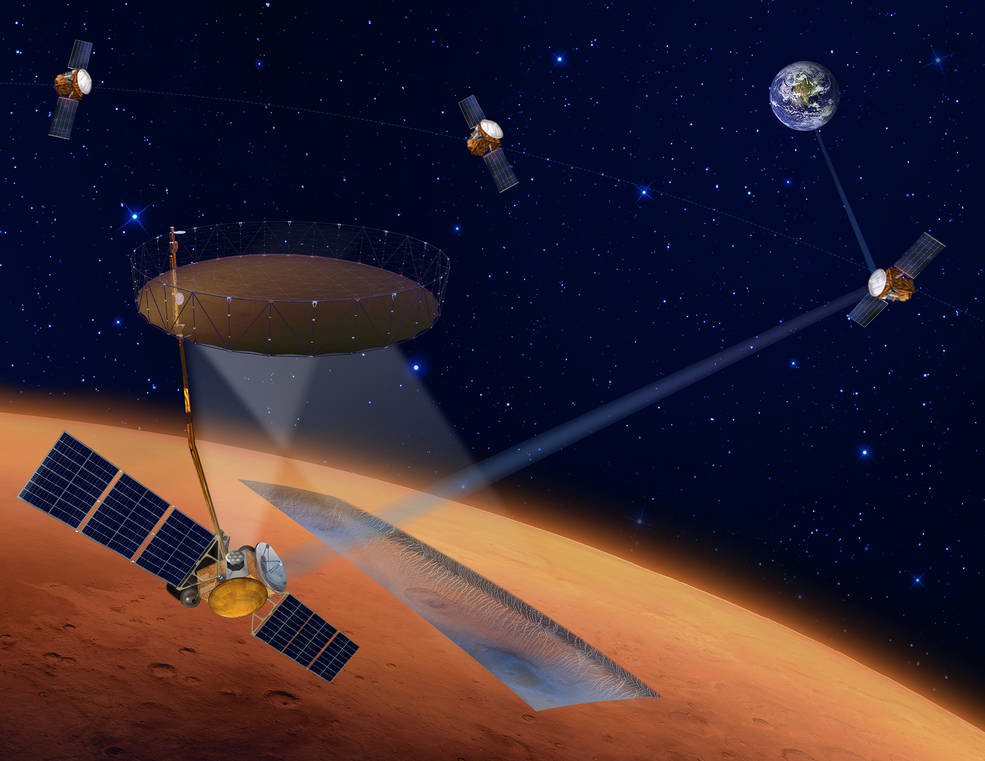 This artist illustration depicts four orbiters as part of the International Mars Ice Mapper (I-MIM) mission concept. Low and to the left, an orbiter passes above the Martian surface, detecting buried water ice through a radar instrument and large reflector antenna. Circling Mars at a higher altitude are three telecommunications orbiters with one shown relaying data back to Earth.
This artist illustration depicts four orbiters as part of the International Mars Ice Mapper (I-MIM) mission concept. Low and to the left, an orbiter passes above the Martian surface, detecting buried water ice through a radar instrument and large reflector antenna. Circling Mars at a higher altitude are three telecommunications orbiters with one shown relaying data back to Earth.
Credits: NASA
Under the statement, NASA, the Italian Space Agency (ASI), the Canadian Space Agency (CSA), and the Japan Aerospace Exploration Agency (JAXA) announced their intention to develop a mission plan and define their potential roles and responsibilities. If the concept moves forward, the mission could be ready to launch as early as 2026.
The international Mars Ice Mapper mission would detect the location, depth, spatial extent, and abundance of near-surface ice deposits, which would enable the science community to interpret a more detailed volatile history of Mars. The radar-carrying orbiter would also help identify properties of the dust, loose rocky material – known as regolith – and rock layers that might impact the ability to access ice.
The ice-mapping mission could help the agency identify potential science objectives for initial human missions to Mars, which are expected to be designed for about 30 days of exploration on the surface. For example, identifying and characterizing accessible water ice could lead to human-tended science, such as ice coring to support the search for life. Mars Ice Mapper also could provide a map of water-ice resources for later human missions with longer surface expeditions, as well as help meet exploration engineering constraints, such as avoidance of rock and terrain hazards. Mapping shallow water ice could also support supplemental high-value science objectives related to Martian climatology and geology.
“This innovative partnership model for Mars Ice Mapper combines our global experience and allows for cost sharing across the board to make this mission more feasible for all interested parties,” said Jim Watzin, NASA’s senior advisor for agency architectures and mission alignment. “Human and robotic exploration go hand in hand, with the latter helping pave the way for smarter, safer human missions farther into the solar system. Together, we can help prepare humanity for our next giant leap – the first human mission to Mars.”
As the mission concept evolves, there may be opportunities for other space agency and commercial partners to join the mission.
Beyond promoting scientific observations while the orbiter completes its reconnaissance work, the agency partners will explore mission-enabling rideshare opportunities as part of their next phase of study. All science data from the mission would be made available to the international science community for both planetary science and Mars reconnaissance.
This approach is similar to what NASA is doing at the Moon under the Artemis program – sending astronauts to lunar South Pole, where ice is trapped in the permanently shadowed regions of the pole.
Access to water ice would also be central to scientific investigations on the surface of Mars that are led by future human explorers. Such explorers may one day core, sample, and analyze the ice to better understand the record of climatic and geologic change on Mars and its astrobiological potential, which could be revealed through signs of preserved ancient microbial life or even the possibility of living organisms, if Mars ever harbored life.
Ice is also a critical natural resource that could eventually supply hydrogen and oxygen for fuel. These elements could also provide resources for backup life support, civil engineering, mining, manufacturing, and, eventually, agriculture on Mars. Transporting water from Earth to deep space is extremely costly, so a local resource is essential to sustainable surface exploration.
“In addition to supporting plans for future human missions to Mars, learning more about subsurface ice will bring significant opportunities for scientific discovery,” said Eric Ianson, NASA Planetary Science Division Deputy Director and Mars Exploration Program Director. “Mapping near-surface water ice would reveal an as-yet hidden part of the Martian hydrosphere and the layering above it, which can help uncover the history of environmental change on Mars and lead to our ability to answer fundamental questions about whether Mars was ever home to microbial life or still might be today.”
The Red Planet is providing great research return for robotic exploration and the search for ancient life in our solar system. This latest news comes ahead of the agency’s Perseverance rover landing on Mars, which is scheduled to take place on February 18, following a seven-month journey in space. NASA and the European Space Agency (ESA) also recently announced they are moving forward with the Mars Sample Return mission.
Learn more about NASA’s Mars Exploration at:
https://www.nasa.gov/mission_pages/mars/main
https://www.nasa.gov/topics/moon-to-mars
Grey Hautaluoma / Alana Johnson
NASA Headquarters, Washington
202-358-0668 / 202-358-1501
grey.hautaluoma-1@nasa.gov / alana.r.johnson@nasa.gov
Last Updated: Feb 3, 2021
Editor: Tricia Talbert
Leave a Reply